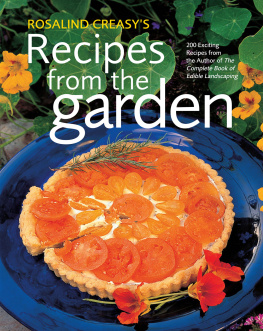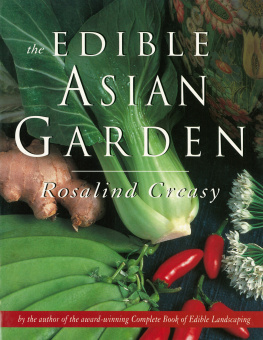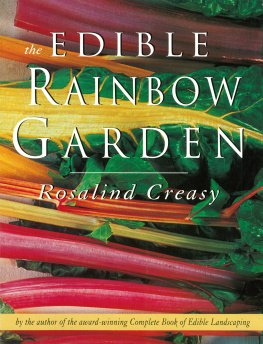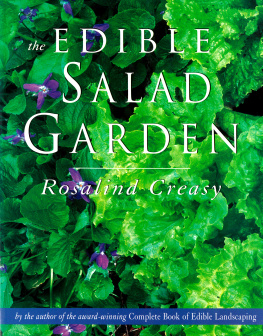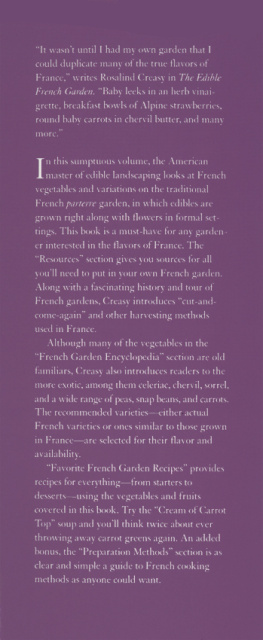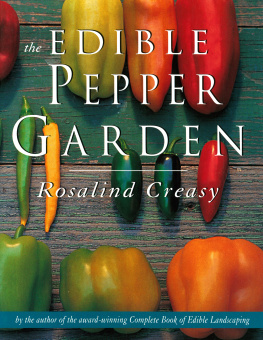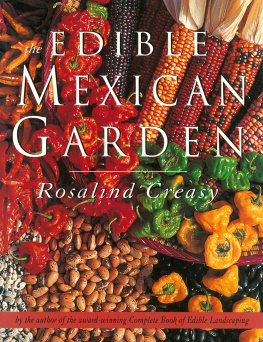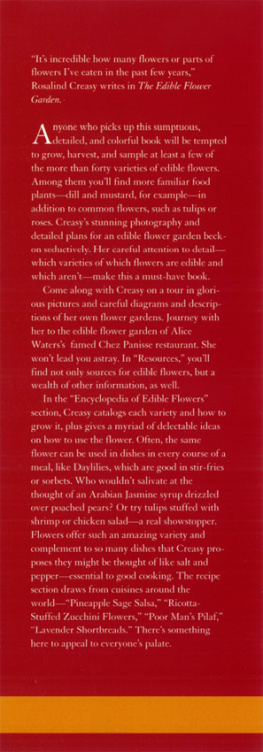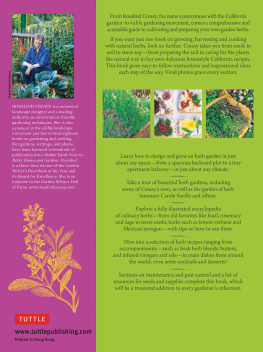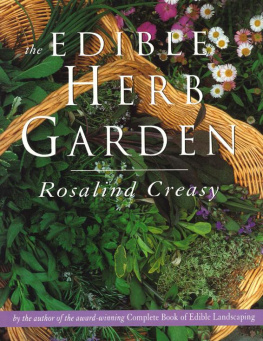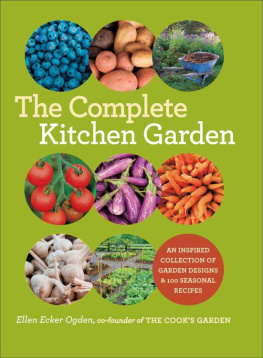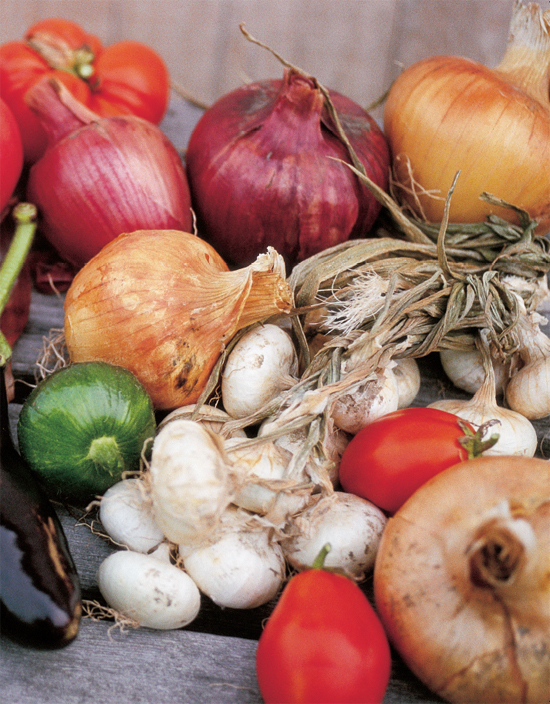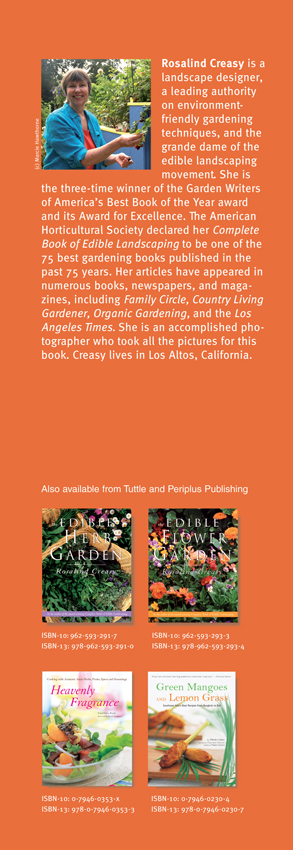Acknowledgments: Special thanks to Gudrun Riter for all her help in testing the recipes and food styling these photographs. Thanks, as well, to Carole Saville for help with this food styling.
The gardening chef
an evolution of american eating
Ho-hum cardboard tomatoes, astringent green bell peppers, and bland, store-bought foodthats how most of America ate a generation or two ago. Where were they hiding the luscious rainbow of heirloom tomatoes? Why werent green peppers allowed to ripen to their sweet natural redmuch less yellow or orange? And why were cilantro, fresh basil, mche, and radicchio kept out of the mainstream? Somehow we got on the wrong track, no longer knowing where our food came from or what was in season. Were now reclaiming our culinary birthrightone deeply connected to the Earththrough home gardening, shopping at farmers markets, and eating local foods.
Throughout my life, gardening and cooking have played major roles. In looking back, it seems that my personal experiences can shed some light on the changes that have been happening in American cuisine during the past 50 years.
My adventures began when I was five years old and my father deeded me my first vegetable gardena little plot adjacent to his big garden in my hometown of Needham, Massachusetts. There I grew offshoots from his strawberry plants, extra tomato and bean seedlings, and lots of flowers. I saw it as an extension of my dollhouse and continually moved the plants around. I dont remember ever harvesting anything from my garden, but that didnt matter because I was having a great time experimenting with plants while enjoying my fathers company.
Over the years, he taught me through example what I later realized were some important links between the kitchen and garden: putting the water on to boil before picking the corn, judging when an asparagus spear is at its peak, and harvesting string beans and partially stringing them at the same time. (Use your thumbnail to cut part way through the bean below the stem and pull the bean down and away. This leaves the stem-y top and the string from one side of the bean hanging on the vine. I now use the same technique with snap peas.)
My mother was the cook in our house. Looking back, I must say that she wasnt very inspiredbless her heart. It was the 1950s, after all. Although she made great roasts and steaks, she boiled most vegetables. Because they were garden fresh and she usually didnt overcook them, her vegetable dishes were pleasant. But Moms repertoire was very limited. She baked or boiled potatoes; it probably never occurred to her to roast, saut, or grill themor any other vegetable for that matter. The only herbs she used were in poultry seasoning for the holidays, and those were dried and came in a tin. She certainly never prepared anything that was remotely spicy.
After I married, my husband Robert and I set up housekeeping in Cambridge, Massachusetts. In retrospect, I cant believe my luck. Cambridge in the early 1960s was home to both Julia Child and Joyce Chen, the doyennes of cooking in America. The town was abuzz with food mania. Both women had written popular cookbooks and Julia had her landmark cooking showwhat inspirations they were! Robert, being a clever, food-loving man with a sophisticated palate, came up with great birthday presents for me. The first was the gastronomic bible of the day, Julia Childs Mastering the Art of French Cooking (written with Louisette Bertholle and Simone Beck), followed the next year by the Joyce Chen Cookbook . Living in the city, my gardening days were temporarily over, but I cant think of better introductions to the techniques for creating some of the worlds best food.
I was home with one baby, then a second, so for well over five years I cooked my way through both books. From Julia, I learned to make hollandaise for my asparagus; to put together what was then an exotic dish with eggplant and zucchiniratatouille; to serve homemade squash soup in a hollowed-out pumpkin; and to make Pommes Anna, a crisp cake of thin potato slices layered with butter. Over the years, I also learned how to make a good chicken stock, blanch vegetables, and even make French bread.
Years later, I gave a slide presentation on edible landscaping to Julia Child and members of the American Institute of Wine and Food. I brought along my dog-eared copy of French Cooking for her to sign. When she saw it, she hugged it, saying that such a well-worn copy was the ultimate compliment. Before she signed my book, she ran her hand over the pages, feeling the splatters and wrinkles, and read some of my hand-written notes: Robert loved it! Make this again and add more herbs, and Freezes well.
Although I never had the good luck to meet her, Joyce Chen was no less vital to my culinary journey. Growing up, my only exposure to Chinese food was the not-so-authentic, and not-so-thrilling, canned chop suey with chow mein noodlesclearly a poor take on one of the worlds most sophisticated cuisines. Although Id had Joyce Chens cookbook for many months, I hadnt used it. Apparently Robert noticed, and so decided to take me to Joyces restaurant. What a culinary awakening that was! The flavors were complex yet easy to like. Inspired by the meal, I was ready to delve into the cookbook. From it, I learned how to make wonton soup, cook rice properly, and stir-fry (not to mention the importance of having all the vegetables and seasonings completely prepared before starting to cook). Compared to French cooking, Chinese techniques were more straightforward. I soon discovered that Chinese dishes were easier to make for everyday meals than Julias fancy French recipes. They also fit better into our limited budget and seemed healthier (using oil instead of butter, less meat, and amounting to far fewer calories). My friends and I started to go to Bostons Chinatown to seek out pak choi, pea pods, fresh ginger, and Chinese cabbageall new to me. Even though we lived in an apartment, I also got back into gardening in a very small way: I grew bean sprouts in my kitchen. They were tasty in my stir-friesnothing like the slimy ones in canned chop sueyand they were lots of fun and easy to grow.
My return to gardening was made complete in 1968 when we moved to the San Francisco Bay area. We bought a ranch-style house in Los Altos on a small lot with a sunny front yard and a very shady backyard. My gardening opportunities were still limited, because vegetables and fruits need lots of sun and the concept of ripping out the front lawn and replacing it with an edible garden had not yet occurred to me. For a few years a friend and I shared her wonderful vegetable garden; we planted the usual rows of corn, beans, tomatoes, basil, peppers, and both summer and winter squash. It was great to once again enjoy luscious homegrown tomatoes and to start the water boiling before we picked the corn. Right in front of our eyesand to our great surprisewe found the green bell peppers ripening to a rich red. Who knew?

This harvest of traditional Italian vegetables features eggplants, red and yellow tomatoes, leeks, peppers, and squash blossoms.


